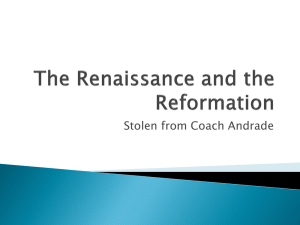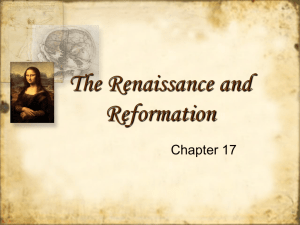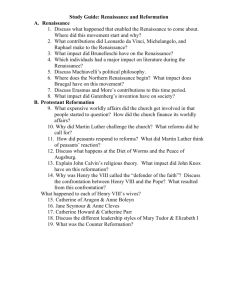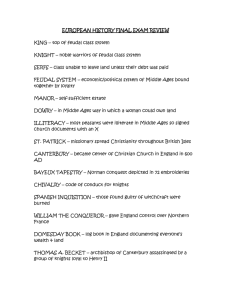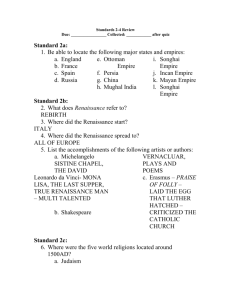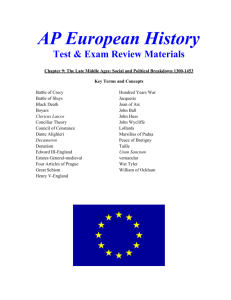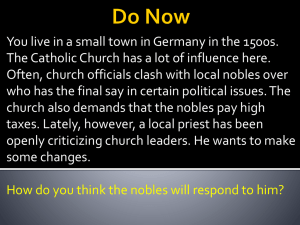The Renaissance - Laurens County School District 55
advertisement
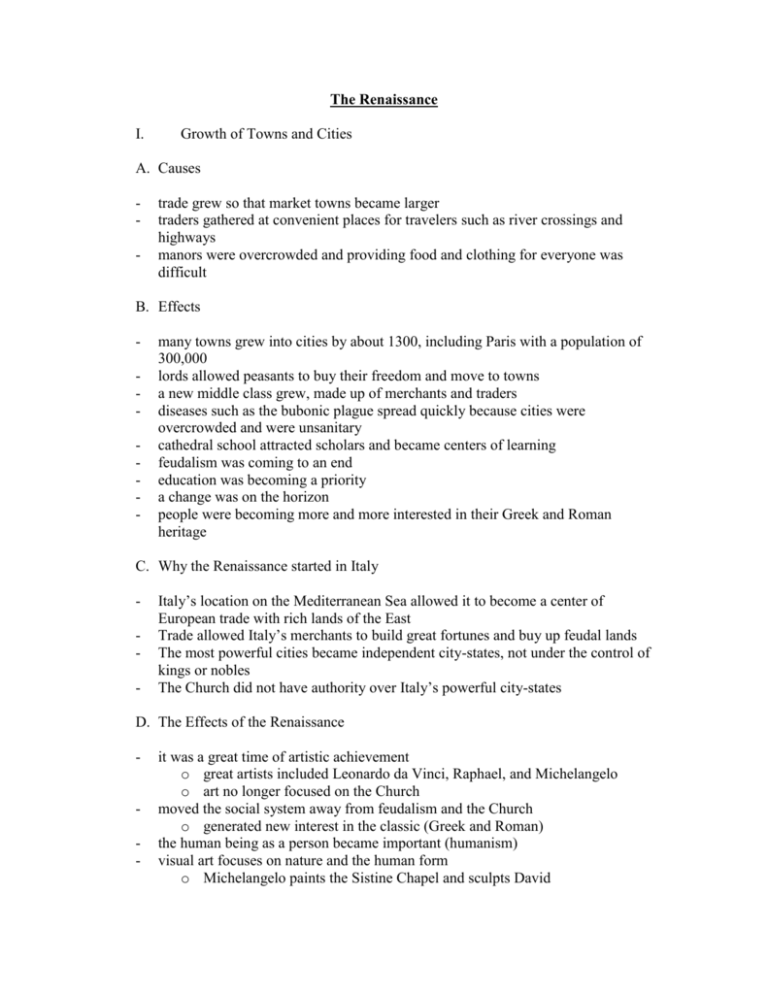
The Renaissance I. Growth of Towns and Cities A. Causes - trade grew so that market towns became larger traders gathered at convenient places for travelers such as river crossings and highways manors were overcrowded and providing food and clothing for everyone was difficult B. Effects - many towns grew into cities by about 1300, including Paris with a population of 300,000 lords allowed peasants to buy their freedom and move to towns a new middle class grew, made up of merchants and traders diseases such as the bubonic plague spread quickly because cities were overcrowded and were unsanitary cathedral school attracted scholars and became centers of learning feudalism was coming to an end education was becoming a priority a change was on the horizon people were becoming more and more interested in their Greek and Roman heritage C. Why the Renaissance started in Italy - Italy’s location on the Mediterranean Sea allowed it to become a center of European trade with rich lands of the East Trade allowed Italy’s merchants to build great fortunes and buy up feudal lands The most powerful cities became independent city-states, not under the control of kings or nobles The Church did not have authority over Italy’s powerful city-states D. The Effects of the Renaissance - - it was a great time of artistic achievement o great artists included Leonardo da Vinci, Raphael, and Michelangelo o art no longer focused on the Church moved the social system away from feudalism and the Church o generated new interest in the classic (Greek and Roman) the human being as a person became important (humanism) visual art focuses on nature and the human form o Michelangelo paints the Sistine Chapel and sculpts David o Leonardo da Vinci paints the Mona Lisa E. Other Tidbits about the Renaissance - - the word Renaissance means “rebirth” during the Renaissance Europeans believed that people could change the world and make it better people became more secular, or worldly Venice was the wealthiest city-state in Italy The Medici were the wealthiest family in Florence, they were bankers, and their influence was unrivaled Machiavelli, a diplomat in Florence, thought people were too greedy and selfcentered – he thought rulers should not try to be good, but do whatever is necessary to keep power and protect a city To deal with other city-states, Italian rulers developed diplomacy, which is the art of negotiating or making deals F. Renaissance Humanism - humanism is a way of understanding the world was based on the values of the ancient Greeks and Romans humanists sought a balance between religion and reason writers during the Renaissance began writing in the vernacular, or everyday language of the people Johannes Gutenberg develops the printing press – the Bible is the first European book printed on the press People begin to study plants, medicine, human anatomy, as well as astronomy G. The Renaissance Spreads - the Northern Renaissance refers to art from places we know today as Belgium, Luxembourg, Germany, and the Netherlands Northern Renaissance artists used different techniques than artists in Italy. Artists in Flanders, a region in what is today northern Belgium, developed oil painting Jan van Eyck was a great oil painter Albrecht Durer was an artist known for his engravings. Engravings are made in wood, metal, or stone, covered in ink. The image is then printed on paper. In England, the Renaissance created great works of theater and literature. William Shakespeare was the greatest English writer of the Renaissance. He wrote tragedies, comedies, and historical plays. The Reformation A. Calls for Church Reform - - Martin Luther was a monk who challenged the Roman Catholic Church. At first Luther wanted only to reform the Catholic Church, leading to the period being called the Reformation. The movement to create Christian churches other than the Catholic Church became known as Protestantism. Desiderius Erasmus felt that humans could use reason to be better Christians People became upset with the Church’s focus on money. They were also upset over the sale of indulgences, or pardons from sin. Martin Luther wrote a list of arguments against selling indulgences, called the 95 Theses. Luther is excommunicated by the pope Luther’s ideas led to a new religious denomination, or organized branch of Christianity. Lutheranism was the first Protestant denomination. B. Politics and Lutheranism - local kings and nobles of the Holy Roman Empire did not want Charles V, the Holy Roman Emperor, to become too powerful Kings realized they could increase their power if they supported Lutheranism. When kings became Lutheran, their entire kingdoms did as well. The Catholic Church could not earn income from the Lutheran kingdoms Charles V warred with the local kings but could not defeat them – Peace of Augsburg ended the fighting C. Calvin and Calvinism - - - Calvin studied theology, the study of questions about God, in Paris Calvin taught that God’s will is absolute and decided everything in the world in advance, including who will go to heaven and who will not. This belief is called predestination. Calvinism encouraged people to work hard at their business and to behave themselves. Calvin’s belief that congregations should choose their own leaders supported the idea of English settlers in North America that they should be able to elect their own political leaders. Calvinism became the basis of many Protestant churches, such as the Puritans and Presbyterians. The Counter Reformation (Catholic Reformation) A. Counter Reformation - - - - - - - Although the Catholic Church warred against Protestantism, it knew it needed to reform some practices. Pope Paul III called a church council at Trent, near Rome, to reform the Church. Catholic clergy were instructed to do a better job teaching people in the faith. The Church created seminars, or special schools, to train priests. The priests belonged to the Society of Jesus, known as the Jesuits, were pope’s agents in Europe. Ignatius of Loyola founded the Jesuits. The Jesuits taught, preached, and fought heresy, or religious beliefs that went against the Church’s. The lower classes in France were mostly Catholic. But many French nobles were Protestants. French Protestants were known as Huguenots. The Bourbons, who were Protestant, were the second most powerful family in France. Huguenot nobles wanted to weaken the king, while Henry II wanted to build a strong government. The son of Henry II, Charles became king in 1560. Because Charles was still a boy when he became king, his mother Catherine de’Medici ran the government for him. Catherine was part of the powerful Medici family from Italy. Catherine opposed the Huguenots. A civil war broke out in France between the Catholics and the Protestants that lasted more than 30 years. It ended when Henry of Navarre, the leader of the Huguenot forces and head of the Bourbon family, became King Henry IV. Henry agreed to become Catholic. Henry IV issued the Edict of Nantes. This recognized Catholicism as France’s official religion but gave the Huguenots the right to worship freely. The Thirty Years’ War was fought between the Catholics and the Protestants in the Holy Roman Empire from 1618 to 1648. During the Middle Ages, Spain was ruled by Muslims. Non-Muslims and Jews had some limitations placed on them, but Jews were treated better than in most European countries at the time. Jewish scholars flourished during this period. When Catholics took control of Spain, Jews and Muslims were no longer welcome. Ferdinand and Isabella established the Spanish Inquisition to ensure religious unity. The Catholic Reformation was brought about in response to the growing number of deserters from the Catholic Church – it was broke so something needed fixing B. The English Reformation - During the 1400s, English nobles had fought each other to control the kingdom. The Tudor family won. Henry VIII was the second Tudor king of England. He wanted to make sure that peace was maintained and that his family remained rulers. - - - - - When Henry’s wife, Catherine of Aragon, did not have a male child, Henry asked the pope to annul his marriage. This would leave him free to marry again. Henry hoped to have a son with another wife to maintain Tudor control in England. The pope refused to annul the marriage. Henry asked the highest religious official in England, the archbishop of Canterbury, to annul the marriage. The pope then excommunicated Henry. In response, Henry declared that the king, not the pope, was the head of the Church of England. All priests and bishops were forced to accept Henry as the head of the Church. Some who did not were executed. Henry gave Church properties and land to loyal nobles. MARY I was the daughter of Henry and Catherine of Aragon. When she became queen in 1533, she tried to reinstate Catholicism as the religion of England. Some people supported this, but others resisted. After she died, her sister Elizabeth became queen. Elizabeth was a Protestant. She restored the Anglican Church as the official religion of England. Some people wanted the Anglican Church to give up some of its Catholic ways. They formed their own congregations that were not part of the Anglican Church. The Puritans were one of these groups. Elizabeth tolerated these groups, but James I and Charles I, who came after, did not. They shut down the Puritan Church and arrested its leaders. C. Missionaries Go Over Seas - In response to the Reformation, many Catholics became missionaries. They traveled across the world to spread their faith. Jesuit missionaries were active in America and Asia in the 1500s and 1600s. Missionaries had great success in the Philippine Islands, which today is the only Asian country with a Catholic majority.
